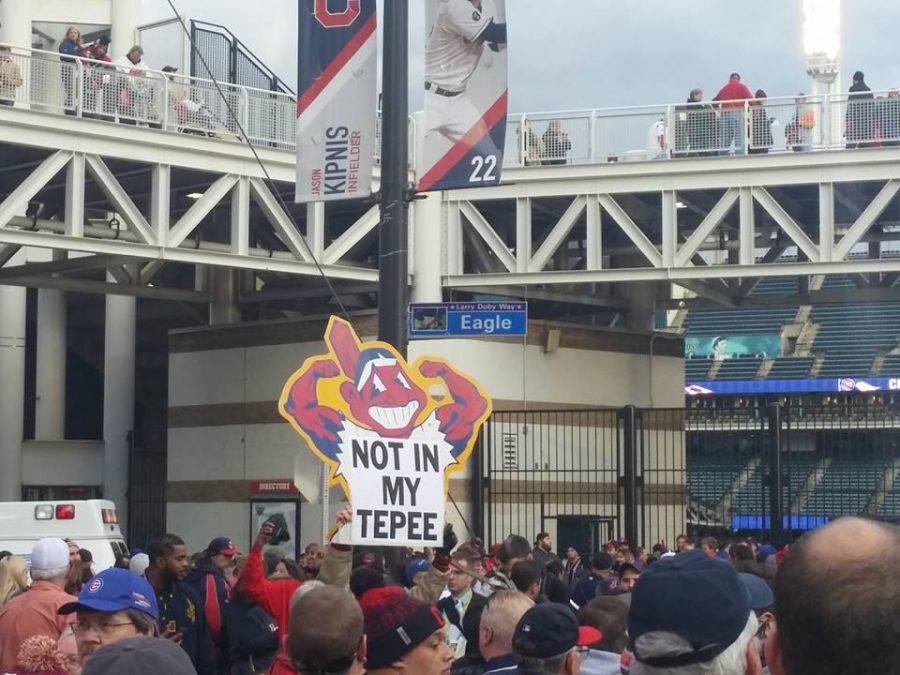Indians Chief Wahoo mascot faces controversy
A Cleveland Indians “Not in my tepee” sign is raised above the crowd gathered outside Progressive Field in Cleveland, Ohio, during Game 1 of the World Series on Tuesday, Oct. 25, 2016.
October 26, 2016
The Cleveland Indians are competing in the 2016 World Series this week, facing off against the Chicago Cubs for the third time Friday — something new for Cleveland. What isn’t new is the controversy surrounding the Indians’ logo, Chief Wahoo.
Chief Wahoo, which has served as the face of the Indians since 1947, has been the subject of controversy, especially for those like Philip Yenyo, a civil rights activist and executive director of the American Indian Movement of Ohio.
Yenyo has been speaking out against and actively protesting the use of the logo for over 20 years.
“In general terms, it’s dehumanizing. It takes us as a culture — a living culture — and degrades us down to a cartoon figure,” Yenyo said. “We know that we are more than just a cartoon. It puts people in the frame of mind that we’re extinct, more so that we don’t matter.”
Danielle Martin-Jensen, Kent State Native American Association president, said the logo makes her feel uncomfortable.
“It’s very aggravating because it’s taking an entire group of people and objectifying them,” Martin-Jensen said. “And it’s so excessive, especially in this region. And that’s very difficult for me to understand,”
Martin-Jensen, who is seeking enrollment with the Oklahoma Choctaw nation, sees the bright, red skinned logo on a regular basis, because she lives so close to Cleveland.
She added that the typical argument people use to defend the logo is honor for Native Americans.
Martin-Jensen said that if the team doesn’t actually have Native American players, and it’s not helping the community, then it is not honorable.
This month in Toronto, activist Douglas Cardinal attempted to legally ban the Indians from using their name or logo when playing the Blue Jays. The challenge was rejected.
“If it was any other culture, that would not stand. We would have everybody out there fighting for basically — human rights,” Yenyo said. “It’s a human right to be seen in a dignified way — and there’s nothing dignified about that.”
The logo itself is more than just a cartoonized version of racial features; it also uses symbolic imagery, such as the red eagle feather in Wahoo’s headband.
Yenyo said he has been to Progressive Field, previously known as Jacob’s Field, and would talk to and educate people in hopes of appealing to their humanity and spiritual beliefs.
“What I tell them is ‘that eagle feather is sacred to our people. You have to earn that’… It’s as sacred to our people as the Christian cross is to Christians,” Yenyo said. “When you take that and you put that on that logo, it not only degrades us as a human being, but it degrades our spiritual beliefs.”
Cynthia Connolly, a Pan-African studies professor, sees the generalizations as telling.
Connolly said there are 567 federally recognized tribes in the country. She is of the Ottawa tribe, and her husband is from the Onondaga tribe.
“Even by saying ‘Native American’ that is a very blanket statement,” Connolly said. “Putting that pan-Indian identity … with the feather and the headband and the big nose — we don’t all look like each other … I think it highlights a general ignorance of Native people as 567 sovereign nations.”
Still, not all see the logo as offensive.
Melissa Hoover, a freshman fashion merchandising major, said she has been going to games since she was about 8 years old. She said seeing the Indian’s advancing in the World Series makes her feel passion for Cleveland sports.
“I guess the animations in itself, like the traditionally redder skin … I could see how it is arguably offensive,” Hoover said. “But I think people find pride in their name and pride in who the Indians are.”
Others, including freshman general business major Samantha Lopiccolo, have simply grown accustomed to its use.
“I never questioned it,” Lopiccolo said. “It felt normal … I don’t see what’s offensive.”
“Offensive,” however, is often a subjective term.
Connolly said she isn’t necessarily offended, but feels that her culture has been frozen in history and, therefore, forgotten.
“We are predominantly thought of and viewed as like this warrior culture from 1880 … and that makes it easy to forget that native people are actually a real modern population,” Connolly said. “This generates a great deal of apathy toward real socioeconomic issues that are plaguing Indian country and our communities.”
As the World Series proceeds, Cleveland may have a chance to clinch another sports victory for the city, winning a title fans have dreamed about for years. But for the Native American community, the fight is not over.
Yenyo said because of the dehumanizing nature of Chief Wahoo, it puts people in the mindset that Native Americans don’t exist.
“It puts us in the past, and we are very much in the present,” Yenyo said.

























